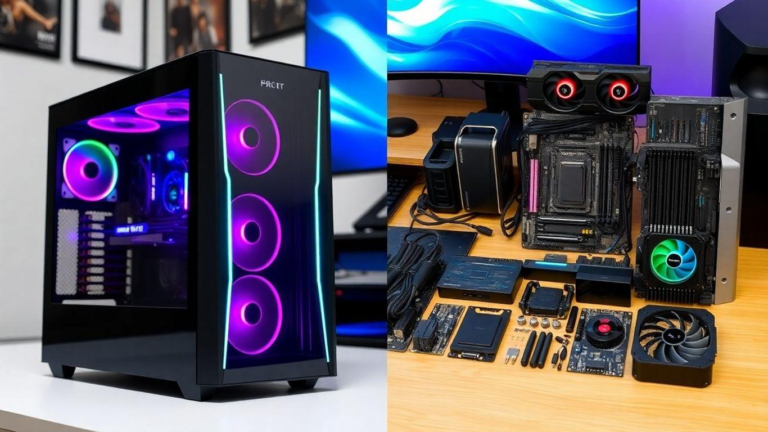Top Mobile Gaming Trends to Watch in 2025: What’s Changing the Game?
Wondering what the top mobile gaming trends to watch in 2025 are? From AI advancements to cloud gaming and AR, discover the key trends shaping the future of mobile gaming. Dive in for a sneak peek of what’s next.
AI-Powered Game Design
Artificial intelligence is becoming essential in transforming mobile game development, revolutionizing various aspects of game design. AI-driven innovations are enhancing everything from procedural generation to intelligent NPCs, offering players more immersive and personalized experiences. These advancements are not just making games more engaging but are also streamlining the game development process, allowing developers to create more complex and interactive virtual worlds. For creators, tools such as the best ai avatar generator are also opening up new ways to design lifelike characters and player identities, adding another layer of depth to gameplay.
AI is also proving invaluable in automating quality assurance, identifying bugs, and dynamically adjusting game difficulty to ensure optimal user experiences. As AI continues to evolve, it is set to play an even more significant role in shaping the future of mobile gaming, making it a crucial area for developers to watch.
Procedural Generation
AI-driven procedural generation is revolutionizing game creation by allowing developers to craft expansive, detailed game worlds with unique architecture and ecosystems. This technology enables the efficient creation of vast and variable environments, enhancing gameplay with unique experiences for players.
AI allows game developers to create more immersive gameplay, ensuring each session feels fresh and engaging.
Intelligent NPCs
Advancements in artificial intelligence are significantly enhancing the behavior of non-playable characters (NPCs), making them more lifelike and interactive. AI allows NPCs to offer adaptive dialogue and respond to player behavior, providing a more immersive gameplay experience.
This results in richer interactions within virtual worlds, making games leveraging this technology more compelling and engaging for players.
Automated QA
AI is revolutionizing quality assurance in game development by using machine learning algorithms to automatically detect bugs, exploits, and balance issues, ensuring smoother gaming experiences. This automation enables developers to deliver high-quality, polished games more efficiently, cutting down on the time and resources required for traditional QA methods.
Cloud Gaming Revolution
Cloud gaming is breaking down hardware barriers, enabling high-quality gaming experiences on lower-end devices. With strong remote servers providing seamless gameplay across various devices, cloud gaming offers user experiences comparable to local hardware. As faster internet speeds and 5G networks become more widespread, the momentum of cloud gaming continues to grow, making it a significant trend in the mobile gaming industry.
Cloud gaming platforms are also being integrated into existing ecosystems like Xbox and PlayStation, rather than operating as standalone cloud platforms. This integration provides game developers with new opportunities to create lightweight, optimized games tailored for a cloud-first audience, expanding access to high-quality gaming experiences through Xbox Cloud Gaming.
Edge Computing
Edge computing is enhancing cloud gaming performance by reducing input lag and bringing processing power closer to players. Regional micro-data centers cut down on the distance data travels, minimizing lag and enhancing the overall gaming experience.
Predictive streaming algorithms combined with edge computing allow cloud gaming platforms to offer faster and more responsive gameplay, significantly enhancing player engagement.
Cross-Platform Play

Cross-platform play is gaining popularity as it allows players from different devices to interact and play together. Games like Genshin Impact have set new standards for console-quality gameplay across devices, demonstrating the potential of cross-platform play. The trend enhances player experiences by allowing seamless transitions between consoles, PCs, and mobile devices, maintaining consistent graphics and saved progress across platforms. Accessories such as Razer mobile controllers further improve this experience by offering console-like precision on handheld devices.
Subscription Models
Hybrid subscription models are emerging in the cloud gaming space, blending traditional ownership with hybrid models of cloud gaming access to enhance player value. These models offer players the flexibility to enjoy a wide range of games without the need for high-end hardware, making high-quality gaming experiences more accessible.
These subscription models cater to diverse player preferences and are poised to become a staple in the gaming industry.
Augmented Reality Integration
Augmented reality (AR) is elevating mobile gaming by providing virtual reality environments that blend seamlessly with the real world. Recent advancements in AR technology are making gaming experiences more immersive, allowing for interactive elements that enhance gameplay. As hardware continues to improve, lighter headsets with superior graphics are expected to further enhance the AR gaming experience.
Incorporating AR into mobile games creates highly interactive and engaging environments, captivating players, and providing them with immersive experiences that go beyond traditional gaming. This trend is poised to redefine how players interact with games, making AR integration a key area to watch in mobile gaming.
Enhanced Immersion
Integrating augmented reality in mobile games creates interactive and engaging gaming environments. By 2025, video games will engage more senses than ever before, enhancing immersion and providing players with highly interactive experiences.
AR offers personalized experiences that captivate players, making it a powerful tool for creating high-quality, immersive gameplay.
Casual and Educational Games
AR-based casual and educational games are experiencing significant growth as mobile hardware and software improve. Key technologies such as ARKit and ARCore are driving the dominance of these games in the casual and educational sectors.
This trend is expanding the broad appeal of mobile games, gaining momentum, and making them more accessible and engaging for broader audiences.
Blockchain and NFTs in Mobile Gaming
Blockchain technology is revolutionizing how value flows within mobile games by:
- Empowering players with digital assets and decentralized systems.
- Creating new ownership models and decentralized economies, allowing players to have true ownership of in-game assets.
- Expanding NFTs into mainstream gaming, offering players the ability to trade digital items freely.
These developments enhance the overall gaming experience.
The shift towards blockchain in mobile gaming is not just about ownership but also about creating player-run economies. By leveraging DAOs and guilds, players can influence game development and participate in decentralized ecosystems, reshaping traditional value transfer mechanisms. This trend is set to redefine how players interact with and derive value from mobile games.
Digital Ownership
NFTs are providing players with true ownership of in-game assets, allowing them to prove rarity and uniqueness across different games. Cross-game marketplaces enable players to trade digital items freely, enhancing the overall gaming experience and creating additional incentives for players to seek out and acquire rare items.
Customizable avatars and characters expressed through NFTs allow players to showcase their unique style through digital wearables and cosmetics.
Player-Run Economies
Player-run economies are prominently controlled by decentralized autonomous organizations (DAOs) and guilds, reshaping how value is distributed within games. These structures play a crucial role in controlling parts of game economies and growth. Supporting user-generated content enables studios to build ecosystems that enhance community loyalty and involvement.
Token rewards incentivize players to engage in creating content, moderating the community, or competing within games, fostering a vibrant and dynamic gaming ecosystem.
Ethical Game Development
Players are asking for greater transparency and inclusivity. They also want game developers to prioritize sustainability. Blockchain technology benefits game development companies by building trust and engagement with transparent, player-driven economies. This trend is creating opportunities for indie developers to innovate without huge budgets, fostering a more ethical and inclusive gaming industry.
Sustainable practices are becoming a core focus in the gaming industry, with innovations aimed at reducing the environmental impact of game development. Eco-friendly practices, such as energy-efficient servers and digital distribution methods, are enhancing the appeal of games to eco-conscious players.
This emphasis on sustainability and inclusivity is set to define the gaming industry in 2025.
Sustainable Practices
Eco-friendly practices in game development encompass reducing environmental impact through innovations such as energy-efficient servers, eco-friendly hardware, and digital distribution methods.
These sustainable development practices enhance the appeal of games to eco-conscious gamers and may become a defining factor for industry leaders in 2025.
Inclusive Design
The gaming industry is focused on improving access for players with diverse abilities, ensuring that gaming experiences cater to a wider audience. Game design is increasingly incorporating technology that enables better experiences for players with disabilities, such as customizable setups, eye-tracking, and voice control.
5G’s Impact on Mobile Gaming
The rollout of 5G networks is transforming mobile gaming by providing:
- Faster, more reliable connections
- Virtually eliminated game lag, allowing for real-time interactions and smoother experiences
- Seamless multiplayer gaming experiences, enhancing player interaction and engagement
- Reduced latency and enhanced graphics, giving gamers a competitive edge
This technological advancement is set to revolutionize the mobile gaming industry through emerging technologies.
Next-gen graphics engines like Unreal Engine 5 and Unity’s latest versions are revolutionizing mobile gaming by enhancing visual fidelity. These engines provide capabilities for hyper-realistic textures, dynamic lighting, and fluid animations, elevating the overall gaming experience. The quality of mobile game graphics has improved significantly due to better hardware and real-time streaming technology, allowing mobile devices to handle complex open worlds and advanced physics simulations.
Reduced Latency
5G technology can lower latency to as little as 1 millisecond, which is crucial for real-time gaming. This low latency enables smoother gameplay on low-end devices, which is essential for an engaging experience in multiplayer games.
The implementation of 5G technology enhances overall gaming performance and increases player satisfaction, providing a significant competitive edge.
Enhanced Graphics
Next-gen graphics engines like Unreal Engine 5 and Unity’s latest versions are revolutionizing mobile gaming by enhancing visual fidelity. These engines provide capabilities for hyper-realistic textures, dynamic lighting, and fluid animations, elevating the overall gaming experience.
The quality of mobile game graphics has improved significantly due to better hardware and real-time streaming technology, allowing mobile devices to handle complex open worlds and advanced physics simulations.
Mobile Esports Growth
The growth of mobile esports is reshaping the gaming industry in several ways:
- There has been a significant increase in professional tournaments.
- Spectator experiences have been enhanced.
- The number of mobile esports tournaments has increased by over 200% in the last few years.
- These tournaments offer substantial prize pools that draw top players globally.
- Mobile gaming is transforming into a competitive arena.
- This expansion is attracting a broader audience.
- A vibrant esports community is being fostered.
Enhanced streaming technologies and platforms are crucial for improving the viewing experience of mobile esports fans. Sharing tools for spectators contributes to a better viewing experience, allowing fans to engage more deeply with the competitions. This trend is making mobile esports more accessible and enjoyable for a global audience, further driving its growth and popularity.
Professional Tournaments
The number of mobile esports tournaments has increased by over 200% in the past few years. These tournaments offer substantial prize pools that draw top players globally, showcasing the potential scale of communal gaming experiences.
The landscape of mobile esports is expanding, with an increasing number of tournaments being held globally, transforming mobile gaming into a competitive arena.
Hybrid Monetization Models
Hybrid monetization models are becoming increasingly popular in mobile games, combining different revenue methods like in-app purchases, advertising, and subscriptions to create a varied income approach. This model allows developers to reduce risk by not depending on a single revenue source, enhancing financial sustainability. Hybrid monetization enhances user satisfaction and financial sustainability by offering diverse payment options catering to various player preferences.
In-game advertisements are a primary source of revenue, capitalizing on the high player engagement rates. In-app purchases in hyper-casual games typically revolve around cosmetic enhancements and removing ads, allowing games to monetize a broader user base.
This combination of revenue methods supports the financial success of mobile games, making hybrid monetization models a key trend in the industry.
In-App Purchases
In-app purchases remain a primary revenue source for mobile games, allowing players to buy additional content and features. These purchases can include:
- Virtual currencies
- Power-ups
- Cosmetic items within games. This revenue method is crucial for games to provide additional content and features to players, enhancing their overall gaming experience.
Ad Revenue
Strategically placed ads can generate revenue while minimizing disruptions to the player experience. Successfully implemented ad revenue strategies can significantly boost a game’s financial performance without alienating players.
Integrating ads strategically within games contributes to substantial revenue without disrupting the player experience, supporting the financial success of mobile games.
Summary
The mobile gaming industry is undergoing a transformative period, with numerous exciting trends shaping its future. AI-powered game design is revolutionizing the way games are created and experienced, offering more immersive and personalized gameplay. Cloud gaming is breaking down hardware barriers and making high-quality gaming more accessible, while augmented reality is providing richer, more interactive environments.
The integration of blockchain and NFTs is redefining ownership and value flows within games, empowering players and creating new economic models. Casual games are evolving to offer deeper content and more meaningful experiences, while mental wellness games are gaining popularity for their therapeutic benefits. Ethical game development is becoming increasingly important, with a focus on sustainability and inclusivity.






